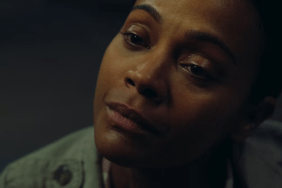On December 8, 1980, former Beatles frontman John Lennon was shot dead in front of his home at the Dakota in New York City by Mark David Chapman, and to this day, it’s still a touchy subject among Lennon’s millions of fans.
When Jarrett Schaefer’s Chapter 27, a drama about Chapman’s days before the shooting, debuted at the Sundance Film Festival last week, a lot of critics took exception with the nature of the film and its slow and deliberate pace. Just as many were impressed by the transformation actor Jared Leto went through to take on the part of Chapman, gaining over 60 pounds in a move that mirrors Robert De Niro in Raging Bull. Loosely based on the book “Let Me Take You Down” which collected Jack Jones’ interviews with Chapman, the film is Schaefer’s debut as a filmmaker, and it’s essentially a one-man movie following Chapman’s time in New York leading up to the shooting with occasional satellite characters like Lindsay Lohan as a fellow fan and Judah Friedlander as a photographer.
The movie isn’t nearly as bad as one might believe from the hatred toward the film seen on sites like BoycottChapter27.org. (A lot of people seem to be angry about the concept of a film that might do anything to glorify John Lennon’s killer.)
ComingSoon.net also had a few issues and questions about the movie after seeing it, so when we had a chance to sit down with Schaefer and the film’s producer Bob Salerno, we asked some of the questions that may have puzzled some of those who’ve already seen the movie.
ComingSoon.net: I haven’t read Jack Jones’ book and I don’t know too much about Chapman’s days before the murder. When I saw the movie, there seemed to be things that to me seemed to be made up. Then I went and looked up the case and learned that all of the stuff shown in the movie really happened. Can you talk about the research to create this film or was most of that in Jones’ book?
Jarrett Schaefer: The Jack Jones book is a phenomenal piece of writing. I think it’s based on 400, could be even more, hours of interviews, with Mark Chapman.
Bob Salerno: He’s probably the only person Mark spoke to in this kind of detail, is that right?
Schaefer: Right. [The book] deals with more than just the 3 days in New York City, it’s his whole life, it’s birth, childhood, early relationships, the trial, time in prison, what his life is like now. Barbara Walters interviewed Chapman in Attica. He was on Larry King Live. People Magazine did a series of three articles. There’s not a tremendous amount, but it’s fairly well documented. And of course, there’s police statements, parole hearings. Once you get arrested for a crime, they ask you a bunch of questions and get all the details.
CS: Why did you decide to just focus on his three days in New York City?
Schaefer: Several reasons. I’ve never been interested in any kind of Freudian analysis of this person, “Daddy beat me so I
” I’m a minimalist. I wanted to create something pure. “The Catcher in the Rye” takes place over 3 days in New York City from Saturday ’til Monday in early December. By freak coincidence, this person was in New York City on the Upper West Side of Manhattan, same place where Holden lives, from a Saturday to a Monday in December.
Salerno: It’s really interesting because I read “Catcher in the Rye” in high school and I really kind of forgot a lot of it until I read the script, then I kind of reread the book. If you go back and reread the book in fact there are a lot of interesting parallels that are going on throughout.
CS: Obviously, “Catcher in the Rye” was part of Chapman’s whole being, so did you make those connections even before starting to work on the movie?
Schaefer: It’s multiple connections. It’s not just that one. There’s a moment where this person was in prison where he realized the initial coincidences, where he reread “The Catcher in the Rye” and began make a list of all the similarities. He made a list of around 200. These are false coincidences, not that they mean anything. This is his mind searching to excuse himself or give this crime meaning.
CS: As far as the inner dialogue or narrative running through Chapman’s head, was a lot of that taken directly from the book?
Schaefer: This character is sort of in the style of Holden Caulfield, him trying on the identity and trying to act out and reaching for the connection with the book and trying to be Holden and trying to have his idea of his time in New York being this idea of “Chapter 27.”

CS: A lot of people are talking about the amazing transformation that Jared went through for the movie. How did you end up getting him for the role? Did he get the script and decide that he wanted to do it and would do whatever it takes to play the part?
Schaefer: That’s about right. Jared read it and was willing to commit himself fully.
Salerno: He really dove in like headfirst into becoming this character and doing this. The weight gain was very difficult for him, because he’s not a naturally heavy guy, so he was constantly eating and putting this on and becoming the character. He actually became the same weight as Mark Chapman. By the end of the film, he actually got to Mark’s actual weight. They obviously had different body structures, but Jared Leto was very heavy there. There’s no prosthetics.
CS: You showed a lot of scenes with him shirtless just to drive home that point. Then of course, he had to lose all the weight to be able to do his rock band thing.
Salerno: I don’t think it was too difficult for him to lose it. He performs on stage all the time and he’s jumping around.
Schaefer: The next time I lose 60 to 70 pounds, I’m going to say, “It wasn’t too hard.” Come on. It’s unbelievable.
CS: When you were working with him on the movie, what was going through his head in terms of his mindset about being that much heavier than normal? Did he stay in the Chapman character the whole time or was he able to be Jared Leto, just heavier?
Schaefer: Well, I mean he’s so committed, he didn’t have too much interest
I don’t want to speak for him or what his process is, but it’s not staying in character as much as living and breathing and trying to maintain this space. In addition to doing things with his body, he was doing things with his voice and things with his mind. I was asking him to thing some really dark thoughts and think about these experiences that this character did to work himself into a state where he could pull the trigger. It’s not an easy thing to do even when you’re out of your mind.
Salerno: I think given the fact that he gained all this weight over a month or two, 60 somewhat pounds is a lot of weight, I think that in itself winds up having a mental debilitation on you as well. Even though it’s for a role, I think it probably helped him in a way. I think there was some mental debilitation going on that worked for him.
CS: Even 26 years later, the shooting of John Lennon is still a very touchy subject, since he was loved by so many people. Could you talk first about shooting at the Dakota, how many days you ended up shooting and how you got permission to shoot there?
Schaefer: We approached them about what we wanted to do. This is a film about the fans waiting outside, so we were never actually on Dakota property, but we were always in communication with the people who represent the building.
Salerno: The building management. What we officially did is our locations manager approached the building manager to request permission to shoot there. They didn’t want us to actually shoot there, so that was fine with us, we didn’t expect to. The city allows us to shoot on public sidewalks. We worked out with the Dakota that it would only be a certain amount of days, I think it was 7 or 8 days that we were actually allowed to shoot in front of the Dakota. We wanted to be respectful throughout the entire film as well, even though we weren’t shooting on the Dakota property, so we did stay in constant contact with the building, and we worked with them. And if we were in their way or they felt they needed some space, they would come to us and ask if we could move over and we always respected that.
CS: Did you have to recreate part of the building somewhere else for the actual shooting? I can’t imagine them wanting you to do that there.
Schaefer: Yes, no one wanted to bring an actor dressed as John Lennon to the Dakota, and no one wanted to have Jared’s character taking out a gun at the real Dakota. It’s all the PG stuff that happens in front of the real Dakota, all the darker things were shot on a soundstage in Brooklyn and our production designer made a stage that has fooled them all.
CS: I wanted to ask about the other people in Chapman and Lennon’s lives. Does Mark Chapman still have any family that might have taken issue with this movie?
Schaefer: He’s married. I believe his mother died and I’m not sure about his father, he may still be alive.

CS: Did Mark and/or Yoko Ono know that you were making this movie?
Salerno: We were in front of the building. Obviously, it’s a difficult thing for someone who personally goes through this, and so we tried to respect that. We did shoot at the Dakota, but tried not to do anything that was graphic. We felt it would be in bad taste to do that. I don’t’ know how she feels about the film. We haven’t approached her. We don’t have any plans or intentions to approach her to show it. I’m sure if she wanted to, she’d be more than welcome to see it, but I can’t imagine [her coming to us].
Schaefer: No one went up to Attica. We didn’t talk to this guy. I think Jared had some conversations with people who knew him and that’s about as far
I didn’t do it. I know he talked to Barbara Walters who interviewed him and he talked to his ex-girlfriend.
CS: The movie’s very slow or as you called it “minimalist.” It was funny that you actually made a joke about the movie’s pace with a reference to “Rosemary’s Baby.” I assume that wasn’t a conversation they really had, but I was curious why you put that joke in there.
Schaefer: Well, I don’t have too much beef with filmmakers, but I do tend to not like films that don’t have jokes i to Mark’s family or Yoko Ono ton them. I don’t go through a day on this planet where I don’t laugh. Humor’s a part of life. Hopefully, there’s a joke or two in this very serious, very dark film. A lot of people are scared of saying something like “Rosemary’s Baby is really slow and nothing happens until the end.” “Chapter 27” is so heightened and aware in a way. You have Lindsay Lohan, the biggest star in the world, playing a fan and talking about fame. There’s a photographer hanging out right next to her and he’s not taking her picture, know what I mean? So it is self-aware and it is heightened in several sense already. Jaret’s a musician, Lindsay’s a musician, this is a film about rock ‘n’ roll, this is a film about the dark side of celebrity, something that these two actors have experience with to be sure. In addition to his brilliant film and TV work and comedy, Judah Friedlander is known for being on “Best Week Ever,” so we’ve already got this celebrity commentary and what it means to be watched in the center of the storm happening on several levels. I’ve never been afraid of humor. I’ve never been afraid of over-determining a film or being self-aware. Every one of Hitchcock’s films are self-reflexive on a level. You have to be aware that you’re making a film. And there’s no disrespect to the realists of the world.
CS: How was it shooting with Jared and Lindsay in that high traffic area outside the Dakota, considering their fame? It would seem like almost an impossible feat to get anything done.
Salerno: For Jarrett, there was a lot of big things–it’s a big topic, big subject and big movie stars. It was not always easy. Trying to shoot Lindsay on her first day and photographers were jumping in front of the camera to get Jared and Lindsay pictures together. It definitely made things more complicated, on top of the normal complications that you would have as a first-time filmmaker or as any filmmaker shooting on location in New York, which is always busy and crowded.
Schaefer: I knew it was going to be difficult and you try and preempt as many difficulties as you can, but that only gets you so far. I’m excited because everyone keeps telling me the next one is going to be a piece of cake.
Chapter 27 played over the weekend at the Sundance Film Festival and is still looking for distribution for its inevitable theatrical release.









